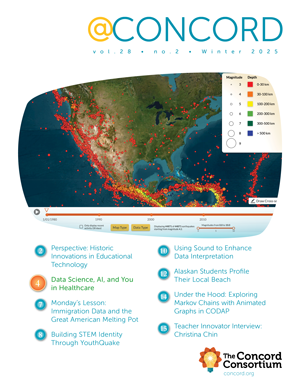Innovator Interview: Amy Pallant
 Q. What were you interested in when you were little?
Q. What were you interested in when you were little?
A. I have been dancing since I was five—first ballet and jazz, and later, contemporary. I love to move and can pick up dance movement quickly. I continue to take yoga and dance classes and perform when I can.
Q. What took you to Oberlin?
A. I was looking for a liberal arts college where you didn’t have to be anything but yourself. When I visited, I knew it was the place for me. The same thing happened to my daughter (who is now a sophomore).
Q. How did you get into Earth science?
A. I thought I was going to study biology or pre-med. During my sophomore year I took organic chemistry and an Intro to Geology course. I fell in love with the subject immediately. I liked thinking about space and time, which is what geology is all about. Geology and dance are both about 3D!
Q. Tell us about your time at Woods Hole.
A. While at Oberlin, I did a month-long internship at Woods Hole Oceanographic Institution. After graduation, I worked at USGS, where I discovered an extinct microfossil. These fossils are so tiny, they used to be washed through the sieves. I moved to Woods Hole and continued to collect microfossils from the sea floor and do mass spectrometry—studying carbon and oxygen isotopes related to changing global temperatures.
Q. What education projects have you worked on?
A. I was project manager of the Insights in Biology curriculum at EDC, then moved to Turnstone Publishing, Inc., where I developed curriculum that connected student activities in oceanography and astronomy with the work of scientists. We created sixteen units for upper elementary and middle school students. This was the inspiration for including videos in Concord Consortium’s High-Adventure Science curriculum units: expose students to what research scientists are currently doing. Science is not stagnant!
Q. What are you currently working on?
A. I direct the High-Adventure Science project, which is developing Earth science modules with the National Geographic Society and the University of California, Santa Cruz. The goal is to help middle and high school students become Earth systems thinkers and to have students explore uncertainty as part of scientific argumentation.
I’ve also been pulled back to Woods Hole with the TREET [Transforming Remotely Conducted Research] project. Since you can’t get a lot of people aboard a boat, we’re investigating new ways of doing fieldwork in ocean science. The goal is to use telepresence to enable undergraduates to guide remote vehicles from shore. An ethnographer on the project is investigating the cultures of education, scientists and ocean research.
And I’m overseeing research on the InquirySpace project, which is helping high school physical science students do their own research projects. The tools available to students to help visualize the data are amazing.
Q. What’s distinct about the Concord Consortium?
A. I like learning, and I haven’t been on any project where I haven’t had to learn both content and technology. The family-friendly atmosphere is important to me, and the people and culture here are just brilliant. Everyone offers something unique.
This material is based upon work supported by the National Science Foundation under several grants (DRL-1220756, IIS-1147621, OCE-1344250). Any opinions, findings, and conclusions or recommendations expressed in this material are those of the author(s) and do not necessarily reflect the views of the National Science Foundation.
